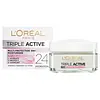What's inside
What's inside
 Key Ingredients
Key Ingredients

 Benefits
Benefits

 Concerns
Concerns

 Ingredients Side-by-side
Ingredients Side-by-side

Water
Skin ConditioningGlycerin
HumectantDipropylene Glycol
HumectantParaffinum Liquidum
EmollientDimethicone
EmollientCetyl Alcohol
EmollientTriethylhexanoin
MaskingSqualane
EmollientPalmitic Acid
EmollientCetyl Phosphate
EmulsifyingArginine
MaskingPhenoxyethanol
PreservativeMethylparaben
PreservativeAllantoin
Skin ConditioningSodium Hyaluronate
HumectantHydroxyethylcellulose
Emulsion StabilisingCarbomer
Emulsion StabilisingDisodium EDTA
Butylene Glycol
HumectantAphanothece Sacrum Exopolysaccharides
AbsorbentSodium Acetylated Hyaluronate
HumectantHydrolyzed Hyaluronic Acid
HumectantAmmonium Acrylates Copolymer
Hydroxypropyltrimonium Hyaluronate
Sodium Hyaluronate Crosspolymer
HumectantPentylene Glycol
Skin ConditioningWater, Glycerin, Dipropylene Glycol, Paraffinum Liquidum, Dimethicone, Cetyl Alcohol, Triethylhexanoin, Squalane, Palmitic Acid, Cetyl Phosphate, Arginine, Phenoxyethanol, Methylparaben, Allantoin, Sodium Hyaluronate, Hydroxyethylcellulose, Carbomer, Disodium EDTA, Butylene Glycol, Aphanothece Sacrum Exopolysaccharides, Sodium Acetylated Hyaluronate, Hydrolyzed Hyaluronic Acid, Ammonium Acrylates Copolymer, Hydroxypropyltrimonium Hyaluronate, Sodium Hyaluronate Crosspolymer, Pentylene Glycol
Water
Skin ConditioningGlycerin
HumectantPentaerythrityl Tetraethylhexanoate
EmollientDimethicone
EmollientButylene Glycol
HumectantButyrospermum Parkii Butter
Skin ConditioningGlyceryl Stearate Se
EmulsifyingPEG-40 Stearate
EmulsifyingCetyl Alcohol
EmollientStearic Acid
CleansingPalmitic Acid
EmollientCamellia Oleifera Seed Oil
Skin ConditioningSorbitan Tristearate
EmulsifyingDimethiconol
EmollientSodium Hydroxide
BufferingPrunus Amygdalus Dulcis Oil
Skin ConditioningDisodium EDTA
Acrylates/C10-30 Alkyl Acrylate Crosspolymer
Emulsion StabilisingTocopherol
AntioxidantPentaerythrityl Tetra-Di-T-Butyl Hydroxyhydrocinnamate
AntioxidantPhenoxyethanol
PreservativeCI 14700
Cosmetic ColorantCI 19140
Cosmetic ColorantWater, Glycerin, Pentaerythrityl Tetraethylhexanoate, Dimethicone, Butylene Glycol, Butyrospermum Parkii Butter, Glyceryl Stearate Se, PEG-40 Stearate, Cetyl Alcohol, Stearic Acid, Palmitic Acid, Camellia Oleifera Seed Oil, Sorbitan Tristearate, Dimethiconol, Sodium Hydroxide, Prunus Amygdalus Dulcis Oil, Disodium EDTA, Acrylates/C10-30 Alkyl Acrylate Crosspolymer, Tocopherol, Pentaerythrityl Tetra-Di-T-Butyl Hydroxyhydrocinnamate, Phenoxyethanol, CI 14700, CI 19140
 Reviews
Reviews

Ingredients Explained
These ingredients are found in both products.
Ingredients higher up in an ingredient list are typically present in a larger amount.
Butylene Glycol (or BG) is used within cosmetic products for a few different reasons:
Overall, Butylene Glycol is a safe and well-rounded ingredient that works well with other ingredients.
Though this ingredient works well with most skin types, some people with sensitive skin may experience a reaction such as allergic rashes, closed comedones, or itchiness.
Learn more about Butylene GlycolCetyl Alcohol is a fatty alcohol. Fatty Alcohols are most often used as an emollient or to thicken a product.
Its main roles are:
Though it has "alcohol" in the name, it is not related to denatured alcohol or ethyl alcohol.
The FDA allows products labeled "alcohol-free" to have fatty alcohols.
Learn more about Cetyl AlcoholDimethicone is a type of synthetic silicone created from natural materials such as quartz.
What it does:
Dimethicone comes in different viscosities:
Depending on the viscosity, dimethicone has different properties.
Ingredients lists don't always show which type is used, so we recommend reaching out to the brand if you have questions about the viscosity.
This ingredient is unlikely to cause irritation because it does not get absorbed into skin. However, people with silicone allergies should be careful about using this ingredient.
Note: Dimethicone may contribute to pilling. This is because it is not oil or water soluble, so pilling may occur when layered with products. When mixed with heavy oils in a formula, the outcome is also quite greasy.
Learn more about DimethiconeDisodium EDTA plays a role in making products more stable by aiding other preservatives.
It is a chelating agent, meaning it neutralizes metal ions that may be found in a product.
Disodium EDTA is a salt of edetic acid and is found to be safe in cosmetic ingredients.
Learn more about Disodium EDTAGlycerin is already naturally found in your skin. It helps moisturize and protect your skin.
A study from 2016 found glycerin to be more effective as a humectant than AHAs and hyaluronic acid.
As a humectant, it helps the skin stay hydrated by pulling moisture to your skin. The low molecular weight of glycerin allows it to pull moisture into the deeper layers of your skin.
Hydrated skin improves your skin barrier; Your skin barrier helps protect against irritants and bacteria.
Glycerin has also been found to have antimicrobial and antiviral properties. Due to these properties, glycerin is often used in wound and burn treatments.
In cosmetics, glycerin is usually derived from plants such as soybean or palm. However, it can also be sourced from animals, such as tallow or animal fat.
This ingredient is organic, colorless, odorless, and non-toxic.
Glycerin is the name for this ingredient in American English. British English uses Glycerol/Glycerine.
Learn more about GlycerinPalmitic Acid is a fatty acid naturally found in our skin and in many plant and animal sources. In cosmetics, it is usually derived from palm oil. It serves many purposes in skincare, acting as a cleanser, emollient, and emulsifier.
As an emollient, palmitic acid helps soften and smooth the skin by preventing water loss. In cleansers, it helps remove oil and dirt while creating foam.
Its emulsifying properties help stabilize products by keeping water and oil-based ingredients from separating.
This may not be suitable for fungal acne-prone skin, as fatty acids like this can sometimes trigger breakouts in sensitive individuals.
Learn more about Palmitic AcidPhenoxyethanol is a preservative that has germicide, antimicrobial, and aromatic properties. Studies show that phenoxyethanol can prevent microbial growth. By itself, it has a scent that is similar to that of a rose.
It's often used in formulations along with Caprylyl Glycol to preserve the shelf life of products.
Water. It's the most common cosmetic ingredient of all. You'll usually see it at the top of ingredient lists, meaning that it makes up the largest part of the product.
So why is it so popular? Water most often acts as a solvent - this means that it helps dissolve other ingredients into the formulation.
You'll also recognize water as that liquid we all need to stay alive. If you see this, drink a glass of water. Stay hydrated!
Learn more about Water